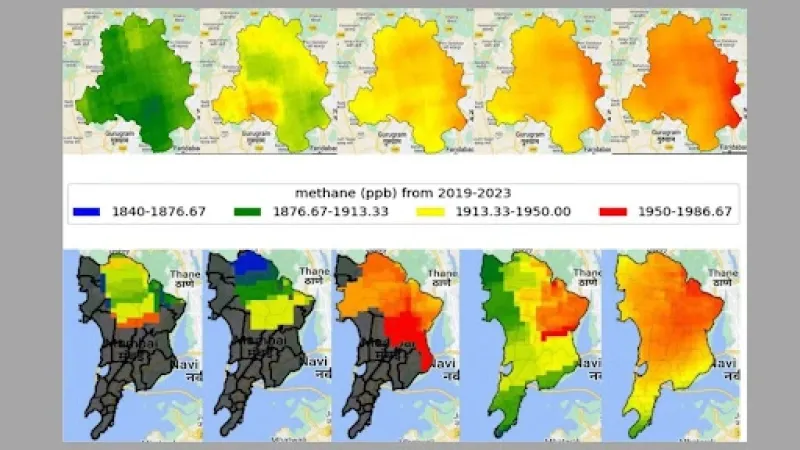
Image of methane cover over Delhi and Mumbai over last few years indicating rising concentrations.
Credits: Authors of the study
In 2024, the world experienced its hottest year ever on record. According to the World Meteorological Organisation, global average temperatures in 2024 were 1.55°C above the 1850–1900 baseline — the reference used to track human-driven global warming. This underlines how difficult it will be to meet the Paris Climate Accord of 2016, which set the goal of keeping average global warming below 1.5°C from the baseline. A total of 195 nations, including India, are signatories to the Paris Accord and have pledged to limit greenhouse gases (GHGs) within nationally determined contribution (NDC) levels.
Accurate knowledge of atmospheric greenhouse gases like Carbon dioxide (CO₂) and Methane (CH₄) is critical to monitoring emission levels and meeting NDC commitments. However, India lacks an extensive network of ground stations to measure GHGs. To bridge that gap, researchers from Indian Institute of Technology Bombay (IIT Bombay), Prof. Manoranjan Sahu and Mr. Adarsh Alagade, turned to satellite data. In a recent study, they demonstrated that remote sensing data can be used to reliably measure the levels of carbon dioxide and methane in metro cities such as Mumbai and Delhi. Using satellite derived measurements the researchers noticed that GHG levels in both cities are on the rise and that they show seasonal and spatial variations. Further, the researchers also developed city-specific statistical models to forecast the level of GHGs.
“By identifying trends and hotspots, satellite-based monitoring gives policymakers evidence to target the worst sources — for instance, prioritising landfill gas capture, traffic management in high-emission corridors, or industrial emissions enforcement — and to evaluate the real-world impact of policies over time,” explains Prof. Sahu regarding the benefit of using satellite-derived data.
Prof. Sahu and Mr. Alagade used data from NASA’s Orbiting Carbon Observatory-2 (OCO-2), which traces carbon dioxide, and the European Space Agency’s Sentinel-5P, which tracks methane. These satellites do not provide direct emission numbers. Instead, researchers relied on specialised algorithms to extract the necessary values from the raw data. To ensure reliability, they validated their satellite readings against the Total Carbon Column Observing Network (TCCON), a network of ground level measuring stations, spread globally, offering highly accurate measurements of CO₂ and CH₄.
“TCCON provides extremely accurate values and is the standard benchmark used globally to correct and evaluate satellite retrievals. That [comparing satellite-derived measures with TCCON values] validation establishes that the satellites are fundamentally measuring the right quantity and that they reproduce measurements with acceptable errors across a wide set of environments,” says Prof. Sahu.
India does not have reliable ground-level measurements. However, the TCCON data are from diverse locations and have enough atmospheric variability. Since their satellite readings align with the diverse data from TCCON, the researchers are confident that their method would apply to the Indian subcontinent.
Using satellite-derived measurements the researchers observed that CO₂ concentrations over Mumbai have been consistently increasing each year between 2014 and 2022. They also noticed seasonal fluctuations, with CO₂ levels peaking in summer, likely due to reduced growth of vegetation and increased emissions, and dropping during the monsoon. A similar analysis for Delhi was not possible because OCO-2 satellite data of sufficient quality were not available for Delhi.
Both Delhi and Mumbai exhibited a rising trend in methane concentrations as well, coupled with seasonal variations. In addition, the data alerted the researchers to the emergence of methane hotspots. They noticed significant increases in methane since 2021, in eastern Delhi near the Yamuna River and major landfills like Ghazipur and Okhla, indicating waste management and industrial activities as probable contributors. Similarly, higher concentrations of methane were observed near Powai and Vihar lakes in Mumbai, likely stemming from a combination of natural emissions from the water and human-related sources such as wastewater. The identification of such hotspots, and the risks posed by poorly managed waste systems and rapid urban growth demonstrate how satellite data can play a major role in informing targeted policy interventions.
To make sense of the patterns and predict changes in GHG levels, the researchers adapted a statistical model called SARIMA(Seasonal Autoregressive Integrated Moving Average), which is often used for forecasting future values based on past data. SARIMA works much like a weather forecast. In simple terms, it uses recent changes in readings, the jump in the readings from one moment to the next, and the average over a fixed number of previous readings, to predict the next month’s value while also factoring in regular and repeating seasonal cycles. The researchers used the satellite-derived data to fine-tune these three parameters and adapt SARIMA for both Delhi and Mumbai.
With the parameters Prof. Sahu and Mr. Alagade identified for Indian contexts, SARIMA can allow policymakers to test whether measures such as upgrading public transport, tightening industrial norms, or improving landfill management are actually producing measurable reductions in emissions. By comparing real-world post-intervention data with SARIMA’s no-intervention projections, the impact of such policies can be assessed more credibly.
There are, however, limits to using satellites.
“Satellites are powerful but not perfect: clouds, dust and city smog can hide or distort measurements; satellites give snapshots rather than continuous local records. All of these factors need careful handling before satellites are used for regulation,” cautions Prof. Sahu.
He notes that the most effective monitoring system will combine the strengths of satellites with those of ground stations.
“Satellites offer wide coverage and identify emission hotspots, while ground stations capture local detail with precision. Used together, they can reconcile top-down observation with bottom-up measurements, improving the credibility of emission estimates and, in turn, climate policy,” he adds, emphasising the need to expand India’s network of ground-based monitoring sites.
Moving ahead, new tools such as machine learning can potentially enhance the scope of predictions and estimates.
“Machine learning (ML) is a powerful tool and will play a big role, but the best future systems mix machine learning with physics-based models, improved satellite sensors, and ground data,” notes Prof. Sahu.





